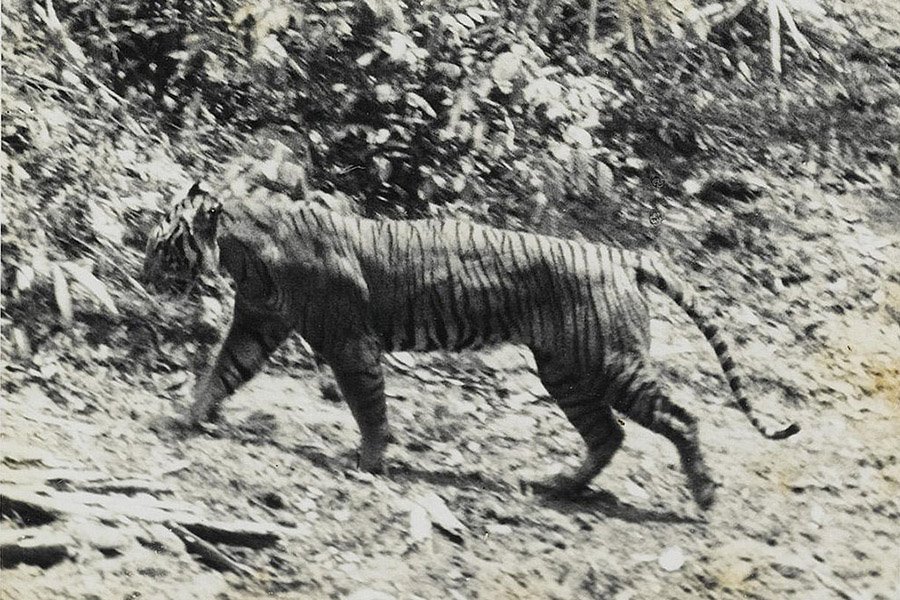Tigers (Panthera tigris) are majestic creatures and apex predators. Their distinctive stripes are recognized worldwide and since ancient times, these big cats have been associated with ferocity and royalty. In the past, they roamed a huge stretch of the globe but human advancement has been their bane. Today, they are listed as either endangered or critically endangered species, and three subspecies have already gone extinct.
In this article, we would discuss these extinct species. What did they look like? Where were they found? Why did they go extinct?
Bali Tiger

- Scientific name – Panthera tigris balica
- Former geographic range – Bali Island, Indonesia
The Bali tiger is smaller in size when compared to other subspecies, but it had the longest tail. It had a dark orange coat and fewer stripes in comparison with other subspecies. These efficient predators were endemic to Bali island, Indonesia. It was a cultural icon and still plays a role in the Balinese Hindu religion.
The Bali subspecies went extinct in the 1940s, the first victims of human activities in tiger habitats. Its extinction is attributed to hunting and habitat loss. Bali island could not support a large tiger population due to its small landmass, severely decreasing the chances of the species surviving human encroachment on their habitat. As cities were built and expanded tigers and humans naturally clashed and unfortunately, the extinction of the former was the result.
The last known Bali tiger was killed in 1937. It was an adult female and was hunted down in Sumbarkima, West Bali. Sightings of the tigers were reported afterward but never proven.
Because they went extinct before the motion picture, no filming of Bali tigers exists today. However, their bones can be found in museums.
Caspian Tiger

- Scientific name – Panthera tigris virgata
- Former geographic range – Asia, Caspian Sea area (Iran, Iraq, Afghanistan, and others)
Also known as Hyrcanian or Turan tigers, the Caspian tiger roamed West and South of the Caspian Sea with its territory including Iraq, Iran, Afghanistan, Russia, Turkey, and Pakistan.
The Caspian tiger outweighed the Bali tiger with males weighing as much as 530 pounds, while females weighed 300 pounds. They were also larger than the Bengal tiger, a living subspecies that is currently the most common tiger subspecies.
It had lighter stripes than both Bali and Bengal tigers with brown and cinnamon stripes being predominant and black stripes found only at the middle of its back, neck, head, and tip of its tail.
It is not known exactly when Caspian tigers went extinct. Loss of both habitat and prey severely affected their population. A pig epidemic led to the death of pigs which was a major source of food for them. The epidemic, coupled with hunting by humans, quickened their extinction.
According to reports, the last Caspian tiger was shot in Golestan National Park in Iran in 1959. However, another was reportedly shot in Turkey in the 1970s. Hence, the 70s is agreed as the date of extinction.
Also read: Tiger Communication: How Do Tigers Communicate With Each Other?
Javan Tiger

- Scientific name – Panthera tigris sondaica
- Former geographic range – Java Island, Indonesia
The Javan was a subspecies of tiger that was native to the Indonesian island of Java. It was first described by Dutch zoologist Pieter Boddaert in 1784. It was one of three subspecies found on Java, the other two being the Bali tiger and the Sumatran tiger.
The Javan tiger was smaller in size compared to the Bengal tiger subspecies. On average, it weighed around 100-140 kg (220-310 lb), and its shoulder height was about 75 cm (30in). Its coat was darker than other subspecies of tigers, with thin and widely spaced stripes. The Javan tiger’s stripes on the forehead were particularly thin and long and felt more like spots. The Javan tiger had a more bearded appearance than other tiger subspecies due to the longer fur around its cheeks and neck.
The Javan tiger’s decline began in the 18th century when Dutch colonizers started deforesting Java for agriculture and the logging industry, leading to habitat loss for the tiger. The tiger’s numbers also significantly declined due to hunting, both for sport and in defense of livestock. In addition, the expansion and increasing human population of Java led to decreased food availability as the prey was hunted out, making it difficult for the Javan tigers to find prey.
By 1938, the Javan tiger was considered critically endangered, with fewer than 25 individuals remaining. The last confirmed sighting of a Javan tiger in the wild occurred in 1972, with the last captive Javan tiger dying in 1987 at the Indonesian Zoo in Bogor. The Javan tiger was announced as extinct in the 1990s by the International Union for Conservation of Nature (IUCN).

Why are Tigers Becoming Extinct?
The primary reason for the extinction of tigers is habitat destruction and fragmentation. Additionally, poaching for their skin, bones, claws, and meat has led to their rapid decline. Poaching of tigers and their prey and injuries sustained in conflicts with humans pose a significant threat to the survival of the species.
What is the Rarest Tiger Subspecies Today?
The rarest tiger subspecies today is the South China tiger. Its scientific name is Panthera tigris amoyensis, and it is native to China, as its name suggests. Its population has dwindled to around 20 individuals in the wild, primarily because of habitat destruction, poaching, and human-tiger conflicts.




